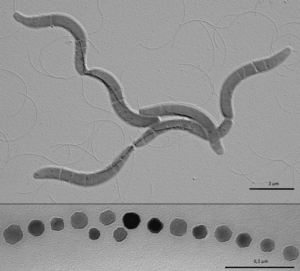Magnetotactic Bacteria: Difference between revisions
No edit summary |
No edit summary |
||
| Line 28: | Line 28: | ||
==References== | ==References== | ||
[1] [http://www.sciencedirect.com/science/article/pii/S0065216407620024 Bazylinski, D. A., & Schübbe, S. (2007). Controlled biomineralization by and applications of magnetotactic bacteria. Advances in applied microbiology, 62, 21-62.] | [1] [http://www.sciencemag.org/content/190/4212/377.short Blakemore, R. (1975). Magnetotactic bacteria. Science (New York, N.Y.), 190(4212), 377-379.] | ||
[2] [http://aem.asm.org/content/70/10/6230.short Simmons, S. L., Sievert, S. M., Frankel, R. B., Bazylinski, D. A., & Edwards, K. J. (2004). Spatiotemporal distribution of marine magnetotactic bacteria in a seasonally stratified coastal salt pond. Applied and Environmental Microbiology, 70(10), 6230-6239.] | |||
[] [http://www.sciencedirect.com/science/article/pii/S0065216407620024 Bazylinski, D. A., & Schübbe, S. (2007). Controlled biomineralization by and applications of magnetotactic bacteria. Advances in applied microbiology, 62, 21-62.] | |||
<!--Do not edit or remove this line-->[[Category:Pages edited by students of Joan Slonczewski at Kenyon College]] | <!--Do not edit or remove this line-->[[Category:Pages edited by students of Joan Slonczewski at Kenyon College]] | ||
Revision as of 02:24, 24 March 2015
Introduction to Magnetotactic Bacteria

Magnetospirillum gryphiswaldense (also referred to as MSR-1) is a gram negative magnetotactic bacteria that is found in shallow fresh water and sediment. They are characterized by a spirillial morphology with flagella at each end of the cell. They are able to orient themselves based on Earth’s magnetic field (magnetotaxis) due to special organelles called magnetosomes.
Other examples:
Bold
Italic
Subscript: H2O
Superscript: Fe3+
Magnetosome Formation
Include some current research in each topic, with at least one figure showing data.
Genetic Influences
Include some current research in each topic, with at least one figure showing data.
Potential Uses in Bioremediation
Include some current research in each topic, with at least one figure showing data.
Conclusion
Overall paper length should be 3,000 words, with at least 3 figures.
References
[1] Blakemore, R. (1975). Magnetotactic bacteria. Science (New York, N.Y.), 190(4212), 377-379.
